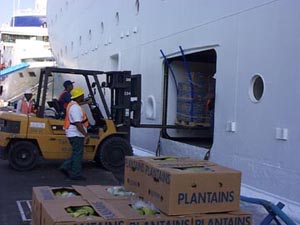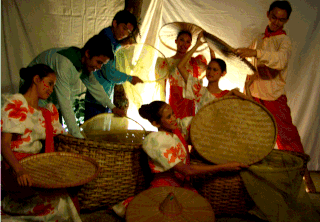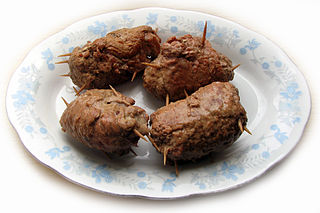Provisioning for sea was crucial in the 19th century due to the lack of modern conveniences such as refrigeration, freeze-drying and canning. Most foodstuffs and liquids such as spirits, molasses, vinegar, and water, were shipped in casks, the balance in wooden crates and other suitable packing materials.

A refrigerator consists of a thermally insulated compartment and a heat pump that transfers heat from the inside of the fridge to its external environment so that the inside of the fridge is cooled to a temperature below the ambient temperature of the room. Refrigeration is an essential food storage technique in developed countries. The lower temperature lowers the reproduction rate of bacteria, so the refrigerator reduces the rate of spoilage. A refrigerator maintains a temperature a few degrees above the freezing point of water. Optimum temperature range for perishable food storage is 3 to 5 °C. A similar device that maintains a temperature below the freezing point of water is called a freezer. The refrigerator replaced the icebox, which had been a common household appliance for almost a century and a half.

Canning is a method of preserving food in which the food contents are processed and sealed in an airtight container. Canning provides a shelf life typically ranging from one to five years, although under specific circumstances it can be much longer. A freeze-dried canned product, such as canned dried lentils, could last as long as 30 years in an edible state. In 1974, samples of canned food from the wreck of the Bertrand, a steamboat that sank in the Missouri River in 1865, were tested by the National Food Processors Association. Although appearance, smell and vitamin content had deteriorated, there was no trace of microbial growth and the 109-year-old food was determined to be still safe to eat.
Contents
It was also commonplace to carry live chickens, both for their eggs and meat, and some small livestock such as sheep, which were butchered when their feed ran out, providing fresh meat before barreled stores such as beef and salt pork were consumed.
The fare for officers and rations for the crew were distinct, as were dining accommodations, with each reflecting their relative stations in society and the navy.
Due to the inability to maintain water fresh for extended periods of time prior to the advent of modern hygiene, shipboard plumbing, and disinfectants, it was common to ship large quantities of beer to provide both hydration and nourishment in times when water aboard fouled. The beer's alcoholic content served as a preservative.
In contrast, grog, a mix of rum and water, was provided and consumed daily (with officers provided their rum straight). The rum allotment per man was retained in the U.S. Navy until the latter part of the 19th century, and all the way until 1970 in the British Navy.

Grog is any of a variety of alcoholic beverages. The word originally referred to a drink made with water and rum, which British Vice admiral Edward Vernon introduced into the naval squadron he commanded in the West Indies on 21 August 1740. Vernon wore a coat of grogram cloth and was nicknamed Old Grogram or Old Grog. The Merriam–Webster Collegiate Dictionary, which agrees with this story of the word's origin, states that the word grog was first used in this sense in 1770, though other sources cite 1749. In modern times, the term grog has had a variety of meanings in a number of different cultures.

Rum is a distilled alcoholic drink made by fermenting then distilling sugarcane molasses or sugarcane juice. The distillate, a clear liquid, is usually aged in oak barrels. Most rums are produced in Caribbean and Latin American countries, but also in other sugar producing countries, such as the Philippines, Guyana, and India.
















